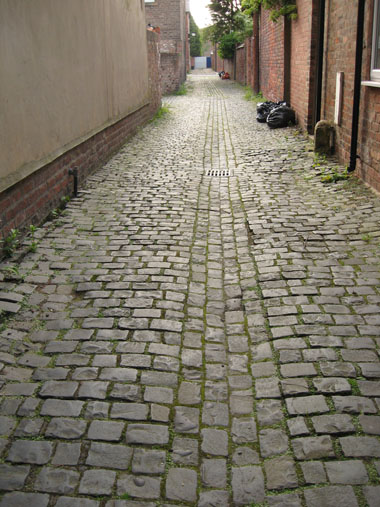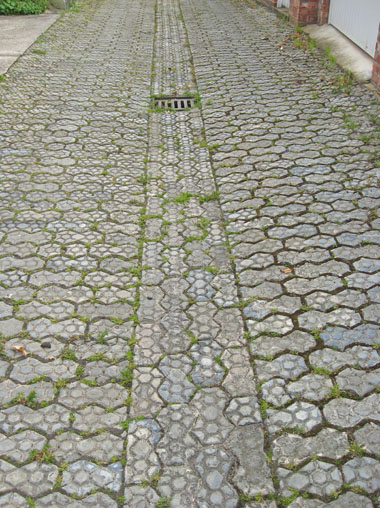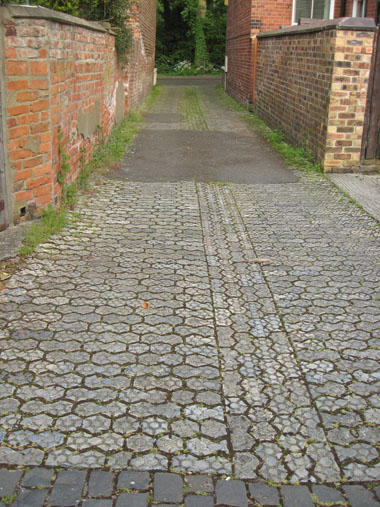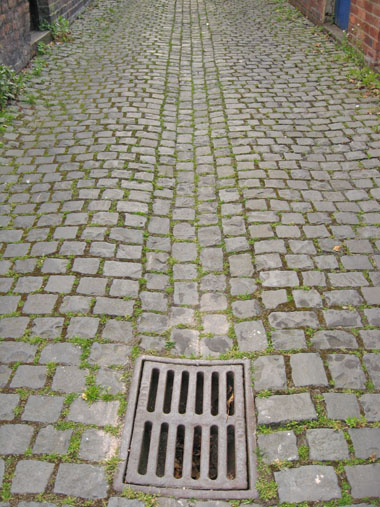Time for another page about paving. Isn’t this exciting? We’re off down the back alleys behind Victorian terraced housing. Don’t all rush at once — and don’t trip over the bin bags.

We use the phrase ‘this is right up your alley’ to mean something you would particularly like, or know something about. I don’t know if the paving down alleys is up many people’s alley, but I’m pressing on regardless, leaving the tarmac pavements and heading off behind the houses.
I’d been trying to find out the name of this back lane paving noticed before, and a recent conversation on Twitter prompted more research. It’s hard to Google something you don’t know the name of, and I did end up going ‘all round the houses’, just like these back alleys pictured do.

Apparently these paving units are called ’slag paviours’. In a City of York Council document they’re also called ‘Rosemary setts’. It’s not often Google fails to pick up any references at all to something, but the only reference to Rosemary setts I could find, beyond the CoYC document, was to a woman of that name.
Both sound rather like characters from a novel, Rosemary Setts being the well-to-do one and Slag Paviours an older lady with a rather shady past perhaps.
I’m wondering what other people call these, if they call them anything at all. Perhaps we never notice them. Perhaps only people wandering around with cameras notice them. The patterns they make are rather pleasing.
These photos are of a back lane in the Bootham area of York. Just a standard northern back alley. I say northern but I’ve never examined the surfacing of back alleys in the south. Paving is a relatively recent interest.
Paying attention to paving leads to many other questions, like where were these made, what are they made of. If anyone knows where the slag paviour factory was in bygone times please share via the comments below.

They’re just a detail overlooked, making up our streetscapes, or rather, the back alleys of where we live. But they’re not manufactured anymore, and when work takes place in back alleys the replacement surface, as illustrated here, is tarmac. Which I can’t see anyone wanting to take photographs of, ever.

In other alleys and back lanes adjoining are these less fancy paving units, ordinary plain setts, presumably also original and dating from the 19th century. Also visually pleasing — well, more so than tarmac. Enjoy them while they last.
And if you think no one cares much about something as mundane as paving, actually many people do care, as a recent story in the Press reminded me. Which is why there might even be a ‘Paving, part 3′ …
Bet you can’t wait.
Elsewhere on the web
Meanwhile, some background reading, the City of York Council Back Lane Resurfacing Policy (PDF)
Update … a few hours later
Well, whaddya know. The questions I’ve been asking above are partly answered in a recently published CoYC document which I’ve just got around to reading, available via the Download now option on this link (PDF), which features those textured paviours on its front page. They’re referred to here as ’stable paviours’, apparently ‘almost unique to York’ and they were ‘manufactured in York from Colliery waste – presumably brought to the city as railway ballast.’
But where? And by whom? …
The document is part of a consultation I was also going to mention when I got around to understanding what it was about. More later …





Excellent and intersting article. My Auntie who lived in The Groves during the 60’s and 70’s had a rather large open courtyard adjoing some (by then redundant!) pig stys and it was paved with these distinctive hexagonal sets. Now I can put a name to them, thankyou!
York back alleys,places for a little ‘Sarcophogus’ type goodnight snog, around midnight.
Wonder how many York folk took notes,and worried about the under foot hexagonal setts,
during their midnight osculations.
Takes a special one to see the beauty in such things,well done,and great photo’s
Brilliant stuff and part of York’s distinctiveness.
It was seeing back alleys like these that made me realise I had arrived in “The North” when I came to York in the late 70s. I hope the ones I remember behind Heslington Road and some of the streets off Hull Road are still there.
Pingback: Hexágonos cerámicos dobles para el York Art Gallery | Ceramica a mano alzada
Aaaaah, I’m so glad you’ve tried to investigate these too! I went on a quest to locate the originals today, in the South Bank alleys, having finally caught a glimpse of the commissioned tiles on the roof of the refurbished York Art Gallery, which were inspired by the hexagonal cobbles. You’re right, it’s impossible to find any sort of history or explanation on Google. “Rosemary” popped up a few times in relation to current Yorkshire-based tile manufacturers, but none of their websites have any detail about what that actually means. Shall keep hunting, I’m so intrigued!
Thank you so much for this fascinating account of what, until I read your page, I had no idea was a specifically York cobble. Your account is full of interest and very nicely done.
I believe this article answers most of the questions raised.
There’s mortar bricks than meets the eye (From The Northern Echo)
http://www.thenorthernecho.co.uk/…/3206104.There_s_mortar_bricks_than_meets_the_ey...
Paving the way: Navvies surfacing part of Marton Road, Middlesbrough, with scoria bricks … They would have called it slag if they were common; scoria made it sound … the Darlington man formed the Tees Scoriae Brick Company to turn slag from … Still, though, they remain in our back lanes and gutters, each one proof that ..
That’s a fascinating and helpful article, thank you. The link in your comment seems to have been shortened/broken on the system here, so here it is again, the article is ‘There’s mortar bricks than meets the eye‘ (Northern Echo, 14 July 2008). It refers to “a double hexagon design which cleverly locked together with its neighbour” – which sounds like the ones above. Though as I understood it ours were made locally, but perhaps not, perhaps they came from Teesside. Fascinating information, thank you for adding this.
Lisa, thanks for this wonderful (as always) account of these pavers. I was just wondering about them and admiring them. And your writeup was the only thing I could find…
They’re called Scoria bricks. Produced by the Tees Scoria Co Ltd dating back tot he late 19th and early 20th century. They’re produced from the ‘slag’ of the pig iron being produced at that time from the Redcar blast furnaces and were made in South Bank. Interestingly, if you break them, you can smell a sulfur like aroma. I know this as i have well over 800 of them whihc i recently lifted from my driveway and am in the process of repurposing. :)
I see this was last year, David, but did you ever use your scoria bricks? I’m fascinated by them and was looking for some to put down as a small path. Would they work like this? Do you have any spare or know a York reclamation yard where I could find them?
Yes,I have used most. I have used them mainly for edging around the garden but also for my door step, garage threshold and driveway threshold. Sadly, the remainder are either ear marked or promised so I’m afraid I have none to spare.
Fascinating Lisa. In answer to the question from Andy T in 2013 (!) about Heslington Road area alleyways – yes the tiles are still here, although much damaged and repaired with tarmac sadly.
Thanks June!
These were the covering in the alley behind my grandmothers house in Kitchener Street , Haxby Road .
Are they still in place ?
I believe that they were also made at Skinningrove Ironworks. In the 1970s I examined one in the lab and it was found to be made up of a mineral called melilite which is found in blast furnace slag. Melilite is a solid solution of akermanite (Ca2MgSi2O7) and gehlenite (Ca2Al2SiO7). A polished section examined under a microscope was found to consist of a mass of very fine interlocking needles that is typical of a structure formed by rapidly cooling a liquid slag. This structure may account for their hard wearing properties.
It is pleasing to know that in Middlesbrough in some recently surfaced tarmac streets there are two rows of slag setts forming the gutters.
Born and brought up in Millfield Road (Right Hand side of street from Scarcroft Road). Back Lane paved with these sets for 2/3 of length.
Interesting comment about giving a grip for horses, remember the coal delivery where the cart was “backed” down from the top of the lane.
When we bought our house we gained responsibility for the alley at the side of it – it just provides access to our garage and next door’s who have right of access. We’re currently having them re-grouted as they tend to gather mud, moss and weeds in between. I understand why the council tarmac them but it’s such a shame. So glad to have found this article and the links, it’s satisfied my curiosity.